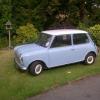There is another option that will require a battery drill and a carbide burr.
Looking into the companion bin with the lining taken out you will see the wheel arch, the flat plate infront of the wheel arch (close out panel) and the the inner sill stiffener panel.
You will see where the heelboard flange meets the closeout panel rear edge and also where the tang of the inner stiffener sits on the closeout panel.
If you can drill a hole as large as the drill chuck will take (normally 1/2") just behind the closeout panel and drilling through the inner sill stiffener you should be able to make out the captive nuts in the back of the heelboard to inner sill mounting bracket.
Now using the carbide burr enlarge the hole width wise until you can fit in a spanner of the right size for the nut.
Using the technique DILLIGAF mentioned for punching out the broken bolt you should be able to dislodge the old captive nut. Once this is done tape you new nut to the ring end of the spanner and insert into the hole. Using a mate get them to push the new bolt through the trunnion and into the heelboard. Now with a bit of patience you should be able to start the new nut onto the bolt. Tighten fully.
Now hopefully you can get the car back on the road. When the first chance becomes available weld a patch over the hole you have made.
If this has been done obviously you will need to think about cutting a section of the outer sill off to gain access to the back of the heel board to weld in new nuts.
If you have a look at the Project Erm link below towards the end of the thread you will see where i have had to do exactly the very method i have just described. Page 45 item 662.


















